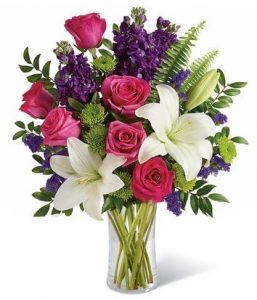BLOG
Mastering the Art of Choosing Flowers for Bouquets
 Over The Rainbow Bouquet
Over The Rainbow Bouquet
Flowers have an enchanting ability to brighten our days, lift our spirits, and evoke a myriad of emotions with their vibrant colors, delicate fragrances, and exquisite beauty. When it comes to creating a stunning bouquet, selecting the perfect combination of flowers is key to crafting a masterpiece that captures the essence of any occasion. In this blog post, we’ll delve into the art of choosing flowers for bouquets, exploring the principles of color, texture, and symbolism to help you create arrangements that are as breathtaking as they are meaningful.
1. Consider the Occasion:
The first step in choosing flowers for a bouquet is to consider the occasion and the message you want to convey. Are you celebrating a joyful milestone like a birthday or anniversary, expressing sympathy and condolences, or simply brightening someone’s day just because? Tailoring your flower selection to match the occasion ensures that your bouquet will resonate with the recipient and reflect the sentiment you wish to convey.
 Lush Lavender Bouquet
Lush Lavender Bouquet
2. Explore Color Palette: Color plays a crucial role in the aesthetic appeal of a bouquet, setting the mood and evoking specific emotions. Consider the recipient’s preferences as well as the theme of the occasion when selecting colors for your bouquet. Vibrant hues like red, orange, and yellow are perfect for expressing joy and celebration, while soft pastels like pink, lavender, and peach convey tenderness and affection. For a sophisticated touch, opt for monochromatic bouquets or explore complementary color combinations to create visual interest and balance.
 The Bold and Beautiful Bouquet
The Bold and Beautiful Bouquet
3. Balance Texture and Form: In addition to color, texture and form are essential elements to consider when choosing flowers for bouquets. Mix and match flowers with different textures and shapes to add depth and dimension to your arrangement. Pair delicate blooms like roses and peonies with textural elements like eucalyptus, berries, or succulents to create contrast and visual appeal. Pay attention to the size and proportion of each flower, arranging them in a balanced composition that highlights their unique beauty while ensuring harmony and cohesion.
 Charming Garden of Love Bouquet
Charming Garden of Love Bouquet
4. Symbolism and Meaning: Every flower carries its own unique symbolism and meaning, making them powerful tools for conveying specific messages and emotions. Research the symbolic significance of different flowers and incorporate those that resonate with the recipient or the occasion. For example, roses symbolize love and passion, lilies represent purity and renewal, and daisies signify innocence and friendship. By incorporating flowers with symbolic significance, you infuse your bouquet with deeper layers of meaning and significance, creating a truly memorable and impactful gift.
 True Love’s Kiss Bouquet
True Love’s Kiss Bouquet
5. Personal Touch: Finally, don’t be afraid to add a personal touch to your bouquet by incorporating meaningful elements or personalizing the arrangement to suit the recipient’s preferences. Consider including their favorite flowers, adding a sentimental keepsake or embellishment, or selecting a container that reflects their style and personality. By infusing your bouquet with personal touches and thoughtful details, you create a one-of-a-kind masterpiece that speaks volumes about your love, care, and attention to detail.
Perfectly Pleasing Pink Bouquet
So in summary, choosing flowers for bouquets is a delightful journey of exploration and creativity, where each bloom serves as a brushstroke in a masterpiece of floral artistry. By considering the occasion, exploring color palettes, balancing texture and form, incorporating symbolism and meaning, and adding a personal touch, you can create stunning bouquets that are as unique and memorable as the individuals who receive them. So go ahead, let your creativity blossom and create bouquets that bring joy, beauty, and love into the lives of those you cherish.
